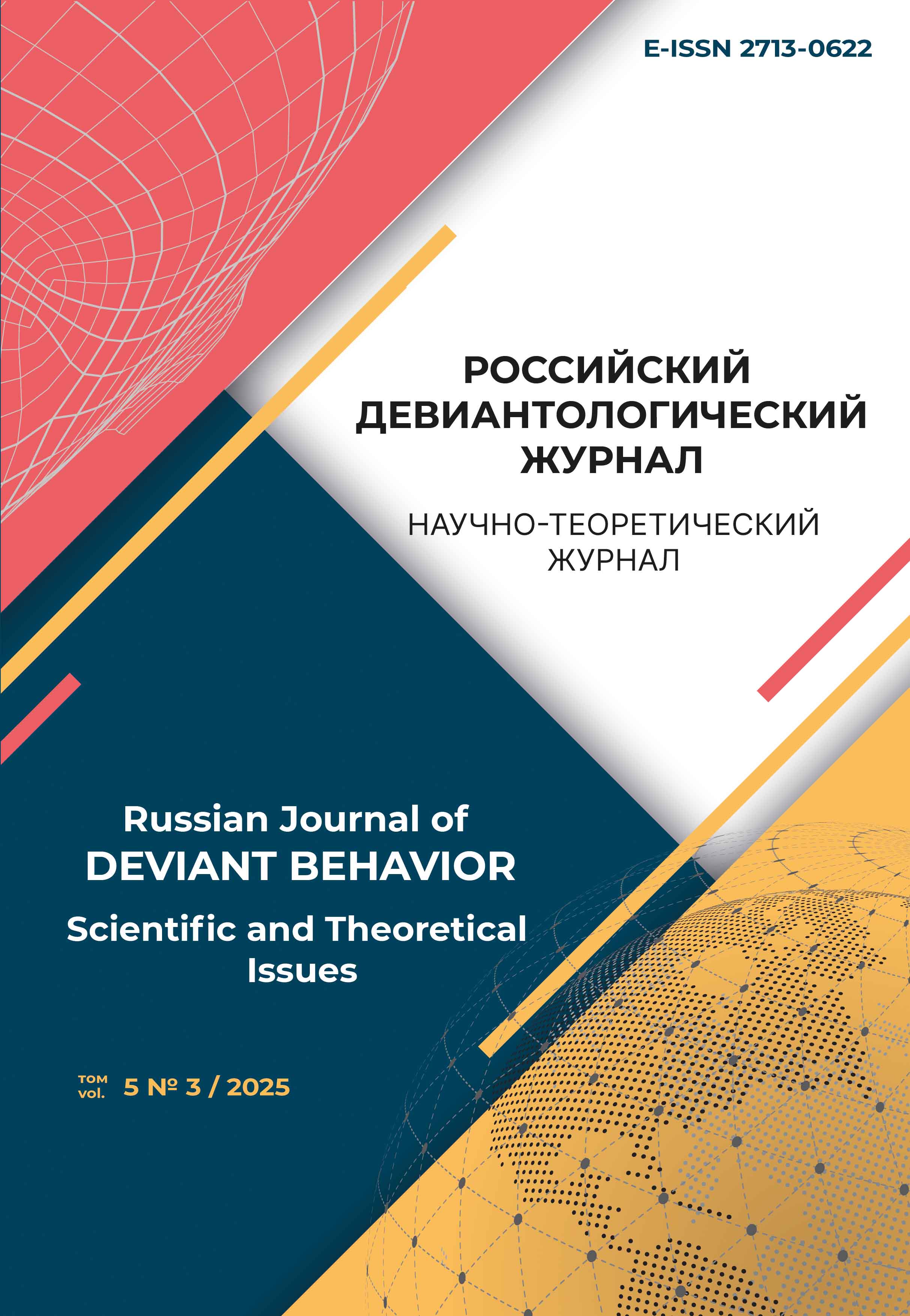Sankt-Peterburg, Russian Federation
UDC 159.9
CSCSTI 15.81
Russian Classification of Professions by Education 37.00.00
Russian Library and Bibliographic Classification 8
Introduction. The article deals with the problem of experiencing moral emotions of guilt, as well as its components – conscience and shame – from the perspective of assessing the risk of recidivism. The emotions of guilt, conscience and shame can be the most important resource in the process of resocialisation due to their ability to influence the value-semantic choices of post-penitentiary individuals. Methods. The author used general scientific research methods aimed at collecting, analysing, systematising and summarising data, as well as analysing normative legal acts and literary sources. Results. Existing models for assessing the risk of recidivism, which make it possible to evaluate the likelihood of repeat offences, were examined and a programme for the resocialisation of post-penitentiary individuals was developed. It is noted that in recent decades, the RNR model, based on assessing the risk and needs of post-penitentiary individuals, has gained the most popularity and has proven its effectiveness in numerous studies conducted abroad. At the same time, there is a recent trend towards considering strengths (personal resources), influenced by developments in positive psychology. In this regard, four generations of relapse risk assessment tools are considered, ranging from clinical assessment to professional structured judgement, considering risk factors, needs and strengths. The features of experiencing guilt, conscience and shame in the presented instruments are analysed. The results of foreign experience are given, in which the correlation between guilt, conscience and shame and crimes committed is established. It is concluded that there is a need to assess the risk of recidivism in the criminal punishment and probation system of the Russian Federation. At the same time, taking into account feelings of guilt and its components, conscience and shame, will allow for a thorough assessment of the post-penitentiary personality and a more effective resocialisation programme.
guilt, conscience, shame, post-penitentiary personality, assessment, risk, recidivism, crime
1. Belik, I. A. (2006). Chuvstvo viny v svyazi s osobennostyami razvitiya lichnosti: avtoref. dis. … kand. psikhol. nauk. Saint Petersburg.
2. Makogon, I. K., Enikolopov, S. N. (2015). Aprobatsiya metodiki izmereniya chuvstv viny i styda (Test of self-conscious Affect-3 - TOSCA-3) Tangney J. P., Dearing R. L., Wagner P. E., Gramzow R. H. Teoreticheskaya i eksperimental'naya psikhologiya, 1, 6–19.
3. Andrews, D. A., & Bonta, J. (1994). The psychology of criminal conduct. Cincinnati, OH: Anderson.
4. Andrews, D. A., & Bonta, J. (1995). The level of service inventory–revised. Toronto, Ontario, Canada: Multi-Health Systems.
5. Andrews, D. A., Bonta, J., & Wormith, J. S. (2011). The Risk-Need-Responsivity (RNR) mode: Does adding the good lives model contribute to effective crime prevention? Criminal Justice and Behavior, 38, 735–755.
6. Aragno, A. (2008). The language of empathy: An analysis of its constitution, development, and role in psychoanalytic listening. Journal of the American Psychoanalytic Association, 56, 713–740.
7. Brennan, T., Dieterich, W., & Ehret, B. (2009). Evaluating the predictive validity of the COMPAS risk and needs assessment system. Criminal Justice and Behavior, 36 (1), 21–40.
8. De Vries Robbé, M., de Vogel, V., & de Spa, E. (2011). Protective factors for violence risk in forensic psychiatric patients. A retrospective validation study of the SAPROF. International Journal of Forensic Mental Health, 10, 178–186.
9. De Vogel, V., de Vries Robbé, M. C., de Ruiter, Y., & Bouman, H. A. (2011). Assessing Protective Factors in Forensic Psychiatric Practice: Introducing the SAPROF. International Journal of Forensic Mental Health, 10 (3), 171–177.
10. Gendreau, P., Little, T., & Goggin, C. (1996). A meta-analysis of the predictors of adult offender recidivism: What works! Criminology, 3 (4), 575–607.
11. Harris, N. (2006). Reintegrative shaming, shame, and criminal justice. Journal of Social Issues, 62, 327–346.
12. Hosser, D., Windzio, M., & Greve, W. (2008). Guilt and shame as predictors of recidivism: A longitudinal study with young prisoners. Criminal Justice and Behavior, 35, 138–152.
13. Janda, L. H, & Bazemore, S. D. (2011). The Revised Mosher Sex-Guilt Scale: its psychometric properties and a proposed ten-item version. J Sex Res., 48 (4), 392–396.
14. Jolliffe, D., & Farrington, D. J. (2004). Empathy and offending: A systematic review and metaanalysis. Aggression and Violent Behavior, 9, 441–476.
15. Lickel, B., Schmader, T., Curtis, M., & Scarnier, M. (2005). Vicarious shame and guilt. Group Process. Intergroup Relat, 8, 145–147.
16. Looman, J., & Abracen, J. (2013). The Risk Need Responsivity model of offender rehabilitation: is there really a need for a paradigm shift? Correctional Service of Canada. International journal of behavioral consultation and therapy, 8, 3–4.
17. Nathanson, D. L. (1992). Shame and Pride: Affect, Sex, and the Birth of Self. New York: Norton.
18. Schalkwijk, F., Stams, G. J., Stegge, H., Dekker, J., & Peen, J. (2016). The conscience as a regulatory function: Empathy, shame, pride, guilt, and moral orientation in delinquent adolescents. International Journal of Offender Therapy and Comparative Criminology, 60 (6), 675–693.
19. Tangney, J. P. (1991). Moral affect: The good, the bad, and the ugly. Journal of Personality and Social Psychology, 61, 598–607.
20. Tangney, J. P., Miller, R. S., Flicker, L., & Barlow, D. H. (1996). Are shame, guilt and embarrassment distinct emotions? Journal of Personality and Social Psychology, 70, 1256–1269.
21. Tangney, J. P., & Stuewig, J. (2011). Shame, guilt and remorse: implications for offender populations. The Journal of Forensic Psychiatry & Psychology, 22 (5), 706–723.
22. Tangney, J. P., Stuewig, J., Mashek, D., & Hastings, M. (2011). Assessing Jail Inmates' Proneness To Shame and Guilt: Feeling Bad About the Behavior or the Self? Crim Justice Behav, 38 (7), 710–734.
23. Tibbetts, S. G. (2003). Self-conscious emotions and criminal offending. Psychological Reports, 93, 101–126.
24. Ullrich, S., & Coid, J. W. (2011). Protective factors for violence among released prisoners - Effects over time and interactions with static risk. Journal of Consulting Clinical Psychology, 79 (3), 381–390.
25. Van Langen, M. A. M., Wissink, I. B., van Vugt, E. S., van der Stouwe, T., & Stams, G. J. J. M. (2014). The relation between empathy and offending: A meta-analysis. Aggression and Violent Behavior, 19, 179–189.
26. Ward, T., & Stewart, C. A. (2003). The treatment of sex offenders: Risk management and good lives. Professional Psychology: Research and Practice, 34, 353–360.
27. Ward, T., Yates, P., & Willis, G. (2012). The good lives model and the risk need responsivity model: A critical response to Andrews, Bonta, and Wormith. Criminal Justice and Behavior, 39, 94–110.
28. Webster, C. D., Martin, M., Brink, J., Nicholls, T. L., & Desmarais, S. L. (2009). Manual for the Short Term Assessment of Risk and Treatability (START) (Version 1.1). Coquitlam, Canada: British Columbia Mental Health & Addiction Services.
29. Wilson, C. M., Desmarais, S. L., Nicholls, T. L., & Brink, J. (2010). The role of client strengths in assessments of violence risk using the Short-Term Assessment of Risk and Treatability (START). The International Journal of Forensic Mental Health, 9, 282–293.














